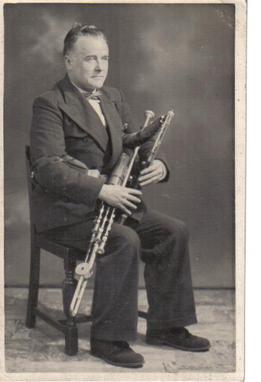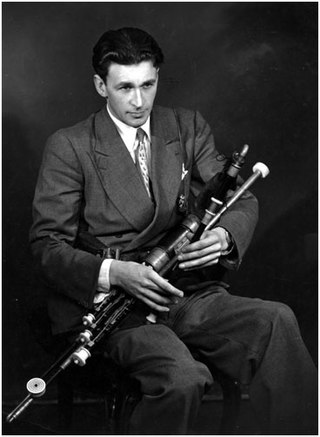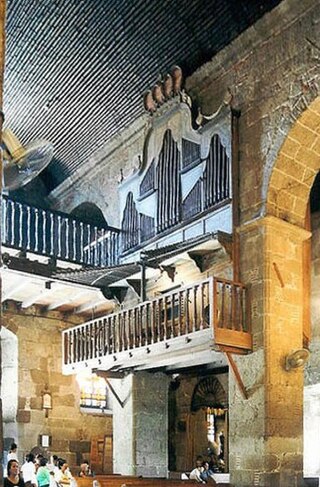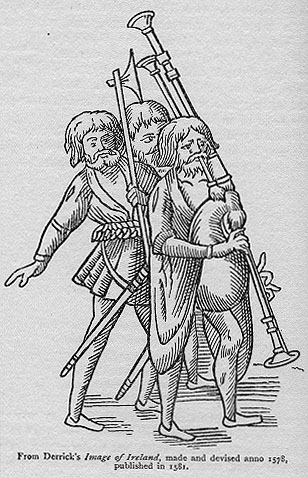
Bagpipes are a woodwind instrument using enclosed reeds fed from a constant reservoir of air in the form of a bag. The Great Highland bagpipes are well known, but people have played bagpipes for centuries throughout large parts of Europe, Northern Africa, Western Asia, around the Persian Gulf and northern parts of South Asia.

The uilleann pipes, also known as Union pipes and sometimes called Irish pipes, are the characteristic national bagpipe of Ireland. Their current name is a partial translation of the Irish language terms píobaí uilleann, from their method of inflation. There is no historical record of the name or use of the term uilleann pipes before the 20th century. It was an invention of Grattan Flood and the name stuck. People mistook the term 'union' to refer to the 1800 Act of Union; however, this is incorrect as Breandán Breathnach points out that a poem published in 1796 uses the term 'union'.

The great Highland bagpipe is a type of bagpipe native to Scotland, and the Scottish analogue to the great Irish warpipes. It has acquired widespread recognition through its usage in the British military and in pipe bands throughout the world.

A pipe band is a musical ensemble consisting of pipers and drummers. The term pipes and drums, used by military pipe bands is also common.

The border pipes are a type of bagpipe related to the Scottish Great Highland Bagpipe. It is perhaps confusable with the Scottish smallpipe, although it is a quite different and much older instrument. Although most modern Border pipes are closely modelled on similar historic instruments, the modern Scottish smallpipes are a modern reinvention, inspired by historic instruments but largely based on Northumbrian smallpipes in their construction.

The Northumbrian smallpipes are bellows-blown bagpipes from Northeastern England, where they have been an important factor in the local musical culture for more than 250 years. The family of the Duke of Northumberland have had an official piper for over 250 years. The Northumbrian Pipers' Society was founded in 1928, to encourage the playing of the instrument and its music; Although there were so few players at times during the last century that some feared the tradition would die out, there are many players and makers of the instrument nowadays, and the Society has played a large role in this revival. In more recent times the Mayor of Gateshead and the Lord Mayor of Newcastle have both established a tradition of appointing official Northumbrian pipers.
The mijwiz is a traditional Middle East musical instrument popular in Egypt, Syria, Palestine, Lebanon and Jordan. Its name in Arabic means "dual," because of its consisting of two, short, bamboo pipes with reed tips put together, making the mijwiz a double-pipe, single-reed woodwind instrument.

Martin Leo Rowsome was the third generation of an unbroken line of uilleann pipers. He was a performer, manufacturer and teacher of the uilleann pipes throughout his life.

An organ pipe is a sound-producing element of the pipe organ that resonates at a specific pitch when pressurized air is driven through it. Each pipe is tuned to a note of the musical scale. A set of organ pipes of similar timbre comprising the complete scale is known as a rank; one or more ranks constitutes a stop.

Séamus Ennis was an Irish musician, singer and Irish music collector. He was most noted for his uilleann pipe playing and was partly responsible for the revival of the instrument during the twentieth century, having co-founded Na Píobairí Uilleann, a nonprofit organisation dedicated to the promotion of the uilleann pipes and its music. He is recognised for having preserved almost 2,000 Irish songs and dance-tunes as part of the work he did with the Irish Folklore Commission. Ennis is widely regarded as one of the greatest uilleann pipers of all time.

A pipe is a tubular wind instrument in general, or various specific wind instruments. The word is an onomatopoeia, and comes from the tone which can resemble that of a bird chirping.
Cornish bagpipes are the forms of bagpipes once common in Cornwall in the 19th century. Bagpipes and pipes are mentioned in Cornish documentary sources from c.1150 to 1830 and bagpipes are present in Cornish iconography from the 15th and 16th centuries.
The Northumbrian Pipers' Society was founded to promote both types of Northumbrian bagpipes – the Northumbrian smallpipes and the half-long pipes, now generally known as the Border pipes. There had been several attempts to encourage the pipes and their music during the 19th century, but no society was formed with this specific aim until the Northumbrian Small Pipes Society in 1893. That society organised a series of competitions, in which Richard Mowat and Henry Clough were both prizewinners. However it was short-lived, dissolving around 1899. Today the society is divided into two branches, the main branch based in Morpeth, and the Cleveland branch based in Sedgefield.

The Las Piñas Bamboo Organ in St. Joseph Parish Church in Las Piñas, Philippines, is a 19th-century church organ. It is known for its unique organ pipes; of its 1031 pipes, 902 are made of bamboo. It was completed after 6 years of work in 1824 by Father Diego Cera, the builder of the town's stone church and its first resident Catholic parish priest.

The gourd mouth organ is a free reed mouth organ played across East and Southeast Asia. It consists of a gourd wind chest with several bamboo or bronze pipes inserted on top of it, the numbers of pipes differing from region to region.
The Regimental Band and Pipes was founded on the Citadel campus in Charleston, South Carolina, in 1909, with marine general Harry K. Pickett in command. The marching band makes up one of the twenty-one companies of the South Carolina Corps of Cadets. In 1991, the band participated in the Edinburgh Military Tattoo in Scotland, becoming the first military college selected for the honor. They returned in 2010 as the only unit from the United States to appear at the Silver Jubilee of the Tattoo and appeared again in 2015.
Na Píobairí Uilleann is a non-profit organization dedicated to the promotion of the Irish Uilleann pipes and its music.

Irish warpipes are an Irish analogue of the Scottish great Highland bagpipe. "Warpipes" is originally an English term. The first use of the Gaelic term in Ireland was recorded in a poem by Seán Ó Neachtain, in which the bagpipes are referred to as píb mhór.
Seán Reid (1907–1978) was an Irish musician known as a player of the uilleann pipes, for promoting the County Clare style of piping, and for being the leader of the Tulla Céilí Band in the late 1940s.

Sompoton or Sumpotan, is a mouth organ made from a gourd with bamboo pipes in northern Borneo. It originated in the state of Sabah and is played by indigenous men and women in Sabah, especially by the Kadazan-Dusun and Murut.














